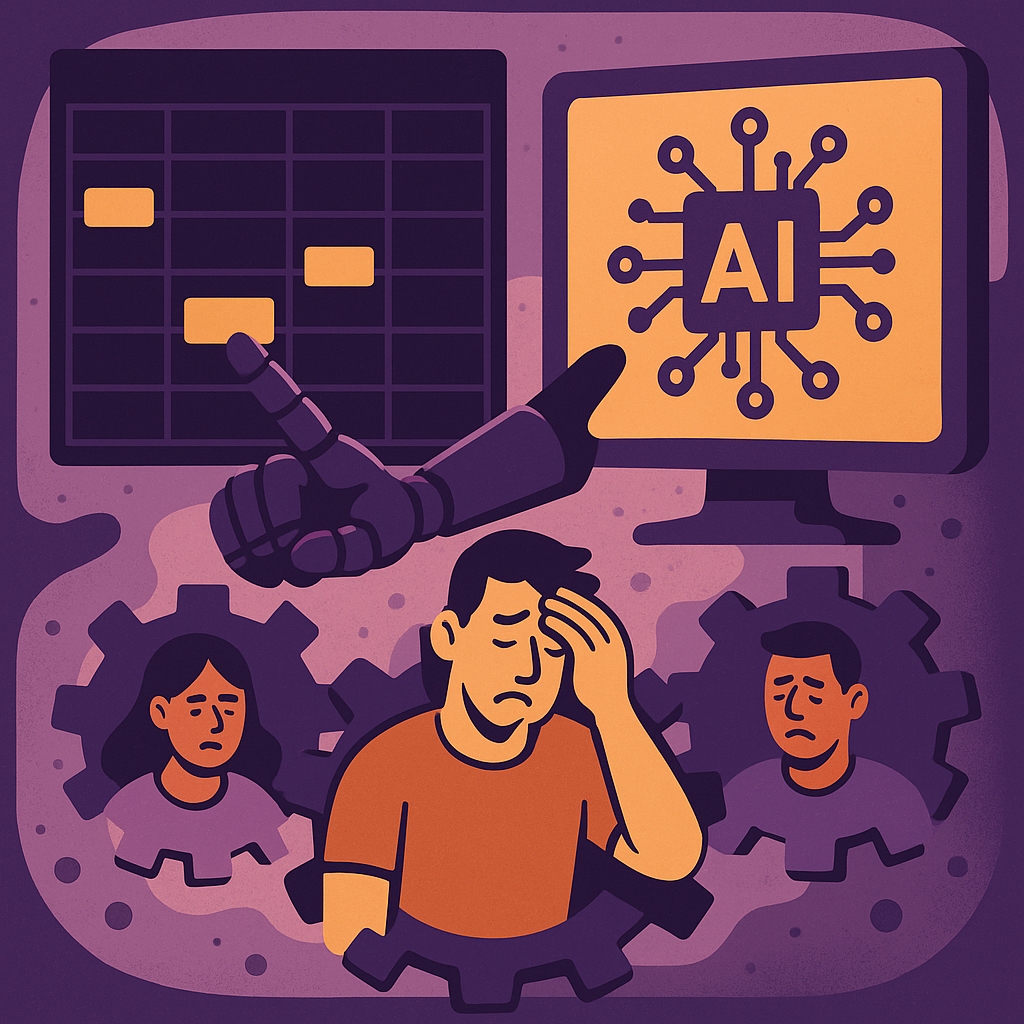Picture this: It’s Monday morning, and Sarah, a retail supervisor, opens her workforce management dashboard. The AI-powered system has done its magic overnight, optimizing schedules, predicting demand, and promising a 15% boost in productivity. The numbers look beautiful on screen. The reality on the floor? Three employees have already called in “sick,” two others are openly grumbling about their shifts, and customer service scores have mysteriously started dropping.
Welcome to the great AI paradox in workforce management, where the promise of optimization meets the reality of human psychology. Spoiler alert: the humans aren’t happy about it.
The Seductive Promise of AI-Powered WFM
Let’s be honest, the sales pitch is intoxicating. AI workforce management systems promise to solve every scheduling headache you’ve ever had. They’ll predict exactly when you need staff, optimize for cost efficiency, eliminate overstaffing, reduce labor costs, and even monitor employee performance in real-time. It’s the workforce management equivalent of having a crystal ball, a financial advisor, and a productivity coach all rolled into one.
Big changes are still on the horizon, and 2024 is shaping up to be a defining year for generative AI, with business leaders planning to make significant investments in these systems. The technology is undeniably impressive. Algorithms that can process thousands of variables in seconds, learning from historical data, weather patterns, local events, and even social media trends to predict staffing needs with uncanny accuracy.
But here’s where the story takes an unexpected turn.
The Cornell Study That Changed Everything
In 2024, researchers at Cornell University dropped a bombshell that should have every WFM professional questioning their AI strategy. Workers tend to react negatively to on-the-job surveillance of any kind, but recent research from Cornell University found that being monitored by AI in particular results in even more dissatisfaction and greater resistance.
The study revealed something counterintuitive: more than 30% of participants criticized the AI surveillance compared to about 7% who were critical of the human monitoring. Think about that for a moment. Employees would rather have their human manager breathing down their neck than an AI system tracking their every move.
This isn’t just about hurt feelings, it’s about measurable business outcomes. The same systems designed to boost performance were actually creating the opposite effect. Productivity dropped. Complaints soared. And perhaps most tellingly, employee turnover began climbing in organizations that had implemented aggressive AI monitoring.
The Psychology Behind the Backlash
Why do humans react so viscerally to AI oversight? It turns out there’s some fascinating psychology at play here.
When a human manager gives feedback, even critical feedback, there’s an inherent understanding that another person is making judgments based on context, experience, and empathy. There’s room for negotiation, explanation, and human connection. But when an algorithm makes the same assessment, it feels cold, absolute, and eerily omniscient.
AI can disempower workers by disrupting organizing efforts through surveillance and scheduling tricks and by accelerating “worker datafication,” the process of reducing employees to data points rather than human beings with complex lives, needs, and motivations.
Imagine being told by an AI system that your productivity dropped 3.7% last Tuesday without any consideration for the fact that you were training a new colleague, dealing with a difficult customer, or simply having an off day. The algorithm doesn’t care about context, it only sees numbers.
The Scheduling Trap

Here’s where it gets really interesting for WFM professionals. AI scheduling systems are becoming incredibly sophisticated at optimizing for efficiency, but they’re often terrible at optimizing for humanity.
These systems can calculate the exact minimum staffing levels needed to maintain service levels, predict when to schedule breaks to maximize throughput, and even determine which employees work best together. But they’re also creating schedules that make employees feel like interchangeable parts in a machine.
Consider the retail worker who gets scheduled for a split shift (four hours in the morning, four hours in the evening) because the AI determined that’s the most cost-effective approach. Or the healthcare worker whose schedule changes every week based on algorithmic predictions, making it impossible to plan childcare or maintain any semblance of work-life balance.
The result? Artificial intelligence has inspired fear among labor unions and legislators over how companies use it to monitor employees. We’re seeing pushback not just from workers, but from policymakers and union leaders who recognize the broader implications of AI-driven workforce management.
The Hidden Costs of “Optimization”
Here’s what most WFM systems won’t tell you in their ROI calculations: the hidden costs of employee dissatisfaction. While your AI system might be saving money on labor costs, it could be hemorrhaging money through increased turnover rates (and the associated costs of recruiting and training), reduced employee engagement leading to poorer customer service, higher absenteeism as employees find ways to game or resist the system, and potential legal and compliance issues as regulations around AI in the workplace evolve.
The irony is profound: systems designed to optimize human capital are often dehumanizing the very people they’re meant to manage.
The Resistance Movement
White and Asian adults are more likely to see potential downsides for workers if AI was used to monitor them, foreseeing workers feeling inappropriately watched or the information collected from this surveillance being misused. This isn’t just abstract concern, it’s translating into real workplace resistance.
Employees are finding creative ways to push back. Some are deliberately introducing “noise” into their performance data. Others are organizing collective responses to AI-driven scheduling decisions. And the most talented workers? They’re simply leaving for companies that treat them more like humans and less like algorithm inputs.
A Different Path Forward
This doesn’t mean AI has no place in workforce management, quite the opposite. The most successful organizations are finding ways to harness AI’s analytical power while maintaining human dignity and agency.
Instead of using AI to monitor and control, forward-thinking companies are using it to empower and support. AI can identify patterns that help employees improve their performance, predict training needs before they become critical, and even help managers have more meaningful conversations with their teams.
The key is transparency and collaboration. When employees understand how AI is being used and have input into the process, resistance drops dramatically. When they feel like partners in optimization rather than subjects of surveillance, the technology becomes an ally rather than an adversary.
The Choice Ahead

We’re at a crossroads in workforce management. Down one path lies the promise of perfect algorithmic efficiency: schedules optimized to the minute, performance monitored in real-time, and human variables smoothed into predictable data points. Down the other path lies a more nuanced approach using AI as a tool to enhance human potential rather than replace human judgment.
Gartner research has identified three key challenges for company leaders in the coming year: new demands for a future-ready workforce, the evolving role of managers, and emerging talent risks for the organization. The companies that will thrive are those that recognize AI’s role in addressing these challenges without losing sight of what makes great workplaces great, which is trust, respect, and genuine care for the humans who do the work.
The choice seems obvious when you put it that way. But judging by the current trajectory of AI adoption in workforce management, it’s a choice many organizations are still struggling to make.
The question isn’t whether AI will transform workforce management (it already has). The question is whether we’ll use it to create better workplaces or just more efficient ones. Because as the research is making abundantly clear, those two things aren’t necessarily the same thing.
And that, perhaps, is the most important lesson of all.


Leave a Reply
You must be logged in to post a comment.